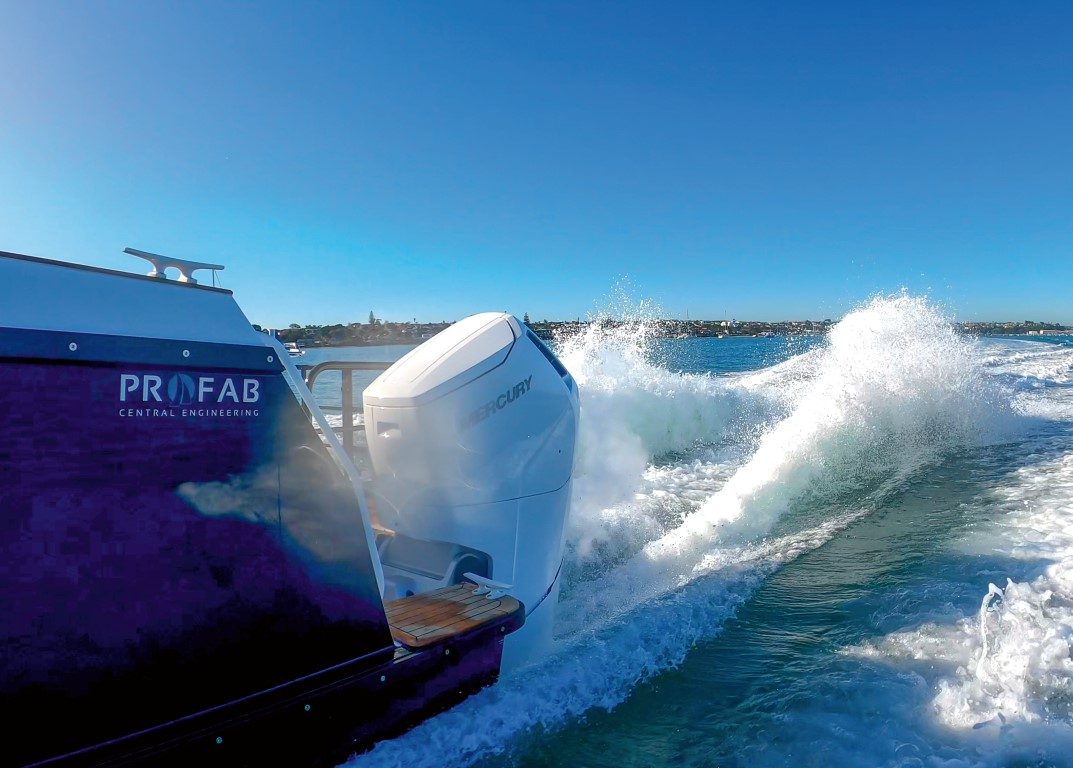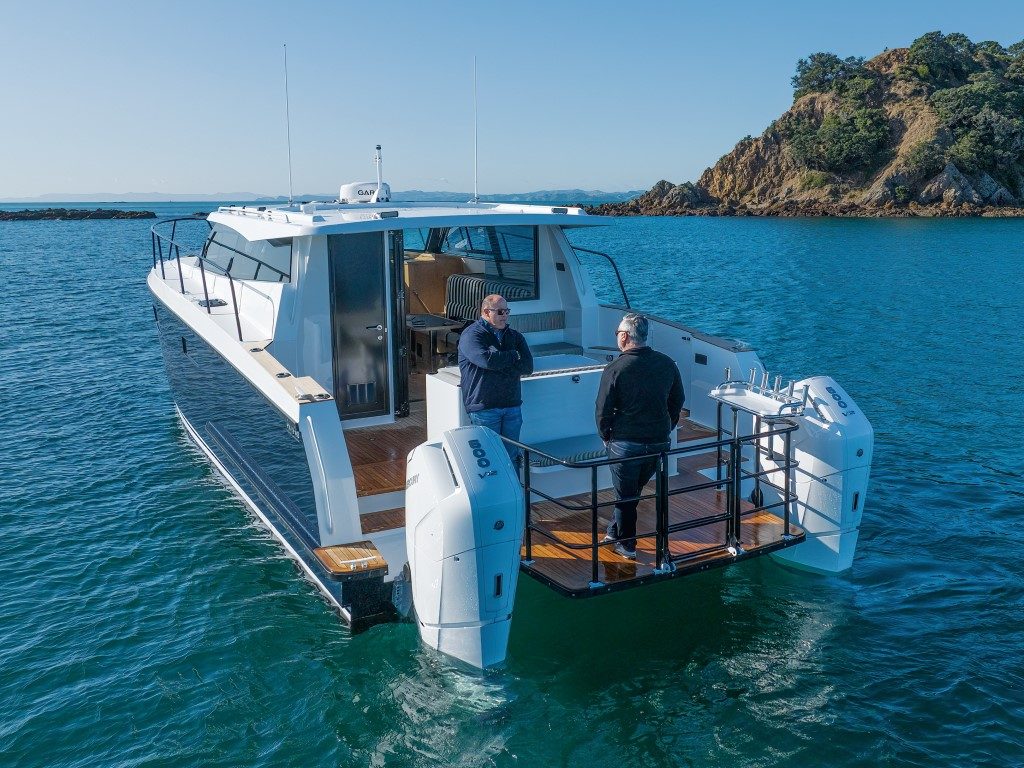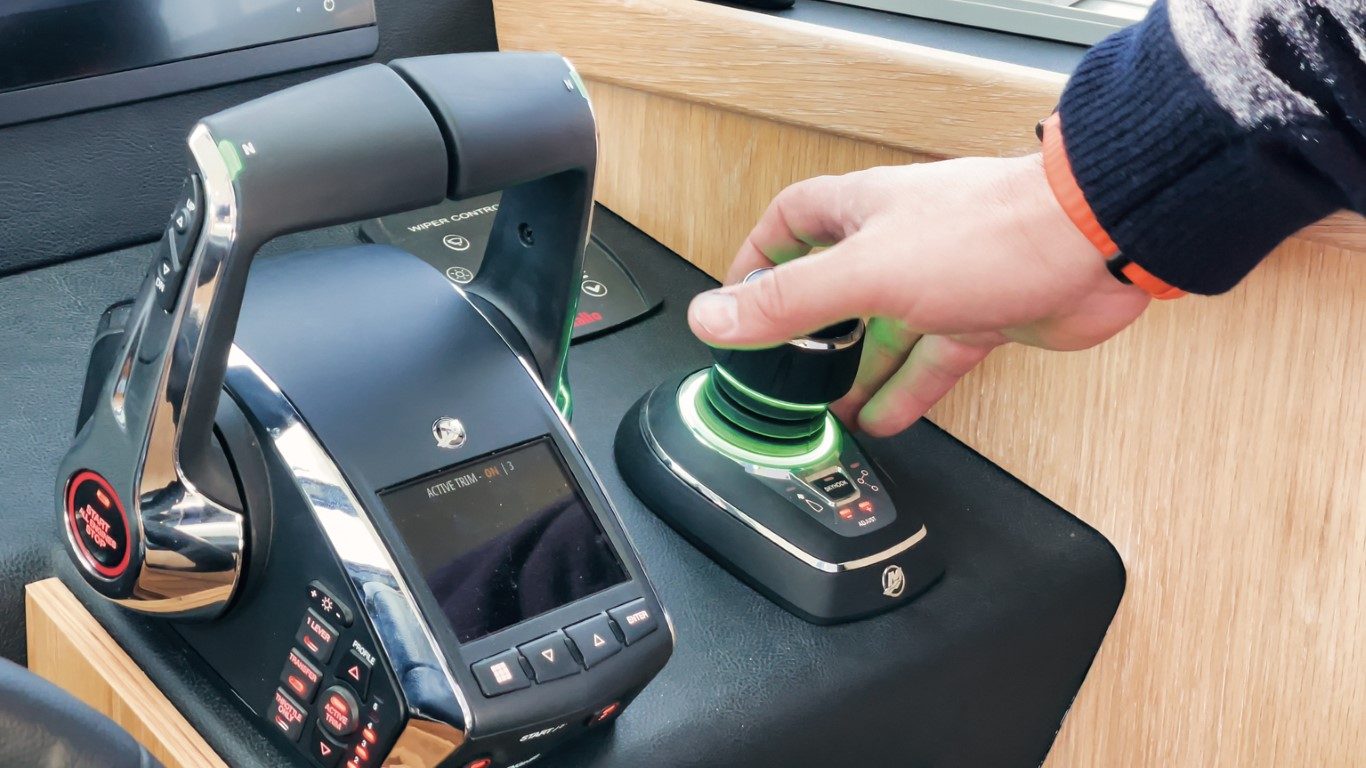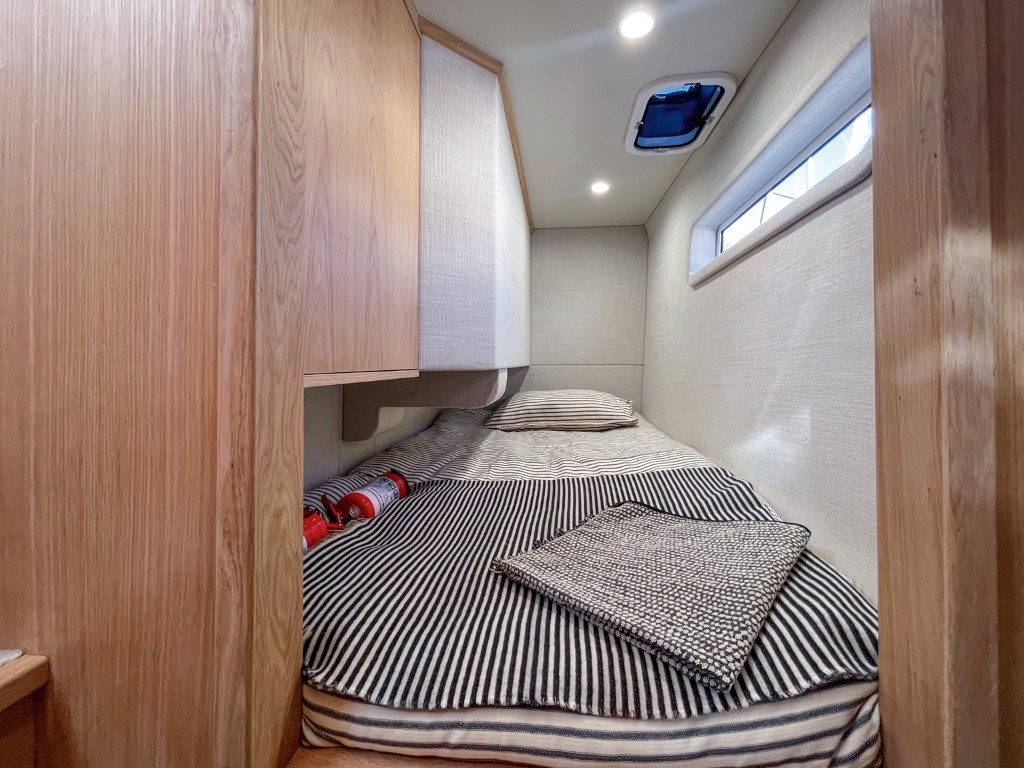‘Behemoth’ is a word which springs to mind or, perhaps more nautically, ‘leviathan’.
- The V12 Mercury engines
- The hull performance
- The quality of the build
- 620 litres of fresh water
Walking up to the Profab 1200 assymetric planing hull power catamaran on the marina berth, my inner Jeremy Clarkson couldn’t help but beam a naughty boy’s grin upon seeing the pair of beautiful Mercury V12 600hp outboards sitting quietly on the stern. I knew they were just waiting to be woken up and set loose.
My immediate urge to call for ‘flank speed’ set the scene for the sea trial of this aluminum craft. Flank speed is typically reserved for situations in which a ship is in imminent danger, such as being attacked by enemy aircraft. In this case, flank speed will probably mean the fish are biting up the coast, so “let’s go!”

More than it seems
As a centre of agriculture and farming, Palmerston North is typically known for its university and its wind farm. But having tested the Profab 1200, a Roger Hill powercat design, it should also be known for boat building.
Profab Central Engineering is a boat building company with a growing list of exceptional custom-built boats to its name. Many of its vessels are the commercial workhorses we see all over New Zealand’s waters, but it can also list superyachts and recreational vessels on its resume. Some of them are (in)famous to many in the boating scene, while others are much more discreet.

The Profab 1200 will probably be one of ProFab’s more discreet builds, but it will certainly be noticed when it blasts past at more than 45 knots, hardly leaving a wake.
The Palmerston North facility allows the ProFab team to build vessels up to 40 metres in length, and the company is currently building two monohulls both over 30 metres long.
The design
Roger Hill Yacht Design was commissioned to design the boat. Roger Hill has been drawing boats for more than 38 years and worked with many of New Zealand’s most famous designers.
A power-catamaran expert, Roger designed the Profab 1200 with a between-hull foil to create lift and improve fuel economy. However, the owners of this particular vessel intend to keep the boat on a custom-built trailer at their property in the Bay of Islands, so it doesn’t have the foil.
 Catamarans have been around since the first wayfinders started to explore the world’s oceans. They are more expansive, stable and often lighter than equivalent-length monohulls. The righting moment of a catamaran is greater than that of a V-hull, improving stability, and with the engines farther apart, power catamarans are more maneouvrable at low speeds.
Catamarans have been around since the first wayfinders started to explore the world’s oceans. They are more expansive, stable and often lighter than equivalent-length monohulls. The righting moment of a catamaran is greater than that of a V-hull, improving stability, and with the engines farther apart, power catamarans are more maneouvrable at low speeds.
Some early power catamarans designs had inherent issues that made them uncomfortable to use. The largest and wettest of those issues was ‘hull sneeze’. This occurs when the boat comes down over a wave, and water pushes up into the tunnel between the hulls and then has nowhere to escape to except in front of the boat. The resulting ‘sneeze’ shoots water out of the tunnel from under the bow, which inevitably blows upwards to hit the windscreens. Riding on any boat with spray flying over the bow isn’t fun.
Some catamarans can also get tricky in a following sea, tracking erratically and ‘digging’ – the two hulls don’t always like to run in a straight line. Then there’s turning. A deep-V monohull leans inward in a turn, whereas a catamaran tends to lean outward.

But there are ways to correct all these inherent issues and also accentuate a catamaran’s benefits, which is what this Roger Hill design has done so successfully. During our on-water test, it became clear that any of the drawbacks found in some power catamarans have been mitigated completely. The hull performance was staggeringly good, and the grip was unbelievable, both a testament to Hill’s design expertise.

Sheer power
Furthering the heritage of the Verado engine family, Mercury reimagined outboard performance to deliver the most powerful, innovative outboard in Mercury’s history. The quad-cam 7.6L V12 600hp Verado is stunning!
The transmission performed for us just as Mercury promised it should. The first gear has a 2.5:1 ratio, providing immediate access to the engine’s enormous torque and boosting acceleration. The second gear has a ratio of 3.0:1, which is automatically and silently selected, stretching performance out to some serious top speeds. The gear shift is so smooth, it takes a lot of concentration to detect when outboards change gear.

The V12’s steerable gearcase, controlled electro-hydraulically, is very responsive. But the highlight of this innovation is how much transom space it saves. It means that the engines don’t need as much space between them and to either side to turn – and at speeds below 10 knots, the gearcase and propellers can move up to 45 degrees to the left or right, compared to 30 degrees for a typical outboard. Consequently, manoeuvrability is next level.
This was amply demonstrated when returning to the marina – the joystick control allowed the boat to track sideways, just using the outboards, to line up the berth.
The engines have a duo-prop set-up, usually only found on inboard engines with sterndrives. The duo-props provide more bite in the water, achieved via a pair of smaller propellers rather than a single, larger propeller. The duo-props are also counter-rotating, to offset the torque from one another, so the boat drives in a perfectly straight line.
The servicing hatch at the top of the cowling means that much of the regular maintenance can be completed with the boat in the water: oil and lubricant changes, and access to the diagnostic port – no more awkward lifting of the cowling (and probably scratching the paint).

These engines have an innovative exhaust bypass. At idle, the exhaust exits above the waterline, but underway, the exhaust discharges underwater. The result was a level of quietness we were not expecting. During the testing session, at 30 knots we could converse without shouting at each other. This low noise level differs from our usual experience when standing next to 1200hp.
The new Mercury throttle and shift and easy to use. The throttle control, activation buttons, automatic trim controls, and Mercury VesselView screen make using the boat very straightforward. The autopilot is integrated with the joystick, which has skyhook technology. Manoeuvring using this joystick and learning its features was impressively simple.
Mercury’s V12 outboard engines have been available for about two years and often become the headline act at any boat show. They are super-cool and an excellent power option for the Profab1200, which can also be configured with a pair of inboard engines. But with this set up giving us over 45 knots during our sea trial, the big Mercs are a combination worth looking at.

The numbers
The Profab 1200’s asymmetric planing hulls launch out of the water like they are trying to fly to the moon. The boat moved so smoothly, we were surprised at how quickly and easily we were skimming across the water.
The ride is brilliantly comfortable. There was no roll or ‘high siding’ when turning at speed, either – we tried to make it happen, but the boat stubbornly stayed level. For a vessel weighing almost 12 tonnes with water and fuel onboard, it shows just how good these asymmetric hulls are.
With an overall length of 13 metres and a beam of 4.69m, the Profab 1200 will fit into a standard 14-metre berth. Draft is only 600mm.

In fast cruise mode – 5000rpm and 32 knots – the fuel burn was 90 litres per hour per engine. When we reduced speed to 25 knots, which felt relatively pedestrian, the fuel burn reduced to 60 litres per hour per engine.
Planing speed was approximately 14 knots, and the ride felt balanced without any stern drag. The fuel burn reduces to just 33.5 litres per hour per engine at this speed.
These new Mercury engines are designed to run on low-octane petrol, so filling the boat with higher-priced fuel is unnecessary.
The layout
The Profab 1200’s starboard hull has a full-sized double bed in the master cabin, with plenty of storage and hanging space, too. The starboard hull also houses a full-sized head, shower, and wet room. The port hull has twin single beds in the forward cabin and a king-sized bed in the aft cabin.

At the helm, positioned centrally in the main saloon, it feels like you are sitting at a conning station – slightly elevated and with great vision around the entire craft. The dashboard layout is practical and uncluttered; the boat has C-Zone for ease of operation.
The galley is spacious, with generous bench space and a sizable Force 10 oven and hob unit. The refrigeration set-up comprised a standard Isotherm fridge under the galley bench, a pull-out drinks fridge under the Captain’s seat, and a large freezer outside in the rear cockpit.

The dining table felt well proportioned, and where the saloon meets the rear cockpit, bi-folding doors and an electrically operated window really open the spaces to one another.
The cockpit sports a significant day head and shower – a great solution for keeping salt water, sand, and dirt out of the main living areas of the boat. It is a capacious cockpit, with huge amount of storage under the sole – plenty of space for the toys and a dive bottle compressor.
The transom area is so large it has its own lounger facing aft past the engines – the boat design takes advantage of this new engine technology and how little space the outboards need to operate.

Walking around the cabin to the bow is easy, thanks to large steps up each side, and the bow area is enormous – certainly enough space to stretch out and relax for a few hours.
The sedan top is home to the typical array of accessories like the radar antenna. It’s made of composite materials rather than aluminium and has built-in tie-down shackles, making it the logical place to store kayaks or stand-up paddle boards.
Expectations exceeded
When testing a boat, we aim to be impartial. But there was something special about this boat. The design, performance and build quality exceeded expectations – so much so, that after our on-the-water testing session, we were not at all ready to take our leave. When we finally did depart, we left wondering how we could get ourselves invited back on board again.

‘Behemoth’ is a word which springs to mind or, perhaps more nautically, ‘leviathan’.
White Pointer has earned the respect of discerning customers in New Zealand and Australia, attracting a loyal and ever growing following for its high-quality, rugged and totally dependable aluminium trailer boats.
The hardtop SP635 shares the same underpinnings as the popular SF 635 which was a completely new model back in 2020.
The pride and joy of a multi-generational family, Bliss resides on a pier that’s home to a couple of other Elite motor launches – Sandspit Marina is a hot-spot for the Bill Upfold-designed vessels, with several calling this small marina home.